Top News
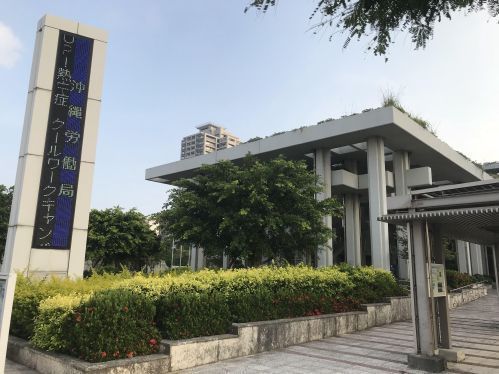
February 8, 2019 Ryukyu Shimpo
The Okinawa Labor Bureau (Takafumi Adachi, bureau chief) announced February 7 that the number of foreign laborers in Okinawa as of the end of October, 2018 increased by 828 people year-over-year (an 11.3% increase) to a total of 8,138 people. The number of businesses employing workers from foreign countries also increase by 146 companies (a 10.1% increase) to a total of 1,591. This is the highest number of total foreign workers and business that employ foreign workers since these figures started being tracked in 2007.
By country, Nepal accounts for the most foreign workers in Okinawa with 1,998, 24.6% of all foreign workers. Following Nepal is Vietnam with 1,186 (14.6%), and the Philippines with 1,014 (12.5%).
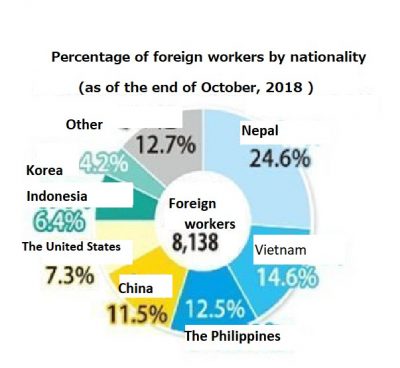
By residency status, “Foreign Exchange Student” was the highest at 2,365, 29.1% of the total. This was followed by “Specialist/Engineer” with 2,152, and “Individually obtained residency status,” which includes permanent residents, long-term residents, and spouses of Japanese nationals, at 1,808.
By industry, excluding “other,” the most common was “hospitality/food service industry” at 1,435, followed by “sales/retail” at 1,135, and “service industry,” which includes anything from temp workers to janitors.
(English translation by T&CT and Sam Grieb)
Go to Japanese
January 29, 2019 Ryukyu Shimpo
In a policy speech at the National Diet on January 28, Prime Minister Shinzo Abe once again stated his intention to move forward with the relocation of Futenma Air Station to Henoko, Nago City. He said, “After more than twenty years of discussions with Okinawa’s prefectural government and its municipalities, we will move forward with the Henoko relocation. As soon as possible we will fully return Futenma Air Station, which is known as the most dangerous base in the world.” Meanwhile, the phrase “pay close attention,” which he has used many times in reference to Okinawa including in his policy speech last year, disappeared. Based on the increasing criticism that Abe “does not pay close attention to Okinawa,” he seems to have avoided use of the phrase. Also, compared with last year his references to the Okinawa base problem decreased drastically.
Deputy Chief Cabinet Secretary Yasutoshi Nishimura spoke about the absence of the phrase “pay close attention” and the decreased reference to the base problem at a press conference on January 28. He said, “We will continue to use various ways to come to an understanding with the prefecture and pay close attention to the feelings of the people of Okinawa, while remaining committed to reducing the base burden.”
In terms of tourism promotion, Prime Minister Abe mentioned that the number of foreign visitors to Okinawa is rapidly increasing. He said, “We will strengthen [Okinawa’s] function as a hub connecting Asia and Japan by greatly expanding its capacity for arrivals and departures,” stressing that construction of the second runway at Naha Airport will progress.
(English translation by T&CT and Megumi Chibana)
Go to Japanese
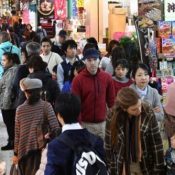
February 3, 2019 Ryukyu Shimpo
The U.S. state of Hawaii, which is in competition with Okinawa over incoming tourist numbers, had a preliminary estimate of 9,954,548 tourists in the 2018 calendar year, roughly 112,100 more than Okinawa, which had 984,2400 tourists visiting during the same period.
Okinawa was unable to achieve a greater number of tourist visitors than Hawaii in 2018. In 2017, Okinawa’s tourist count surpassed Hawaii’s when the preliminary figures were announced, but fell behind when the final numbers came out.
Still, in 2017 Hawaii was ahead by a mere 8,000 visitors, while in 2018 it achieved a more significant lead.
Hawaiian tourism promotion organization Hawaii Tourism Authority announced the preliminary figure on January 31 local time.
Although some months in 2018 saw fewer tourists than the previous year because of a measles outbreak and typhoon, overall 2018 saw an increase of 4.7% in tourists over the previous year.
Hawaii was also concerned that the eruption of the Kīlauea volcano might negatively impact tourism, but 2018 saw a 5.9% increase in tourists over the previous year, meaning that the rate of increase as well as the total number of tourists surpassed that of Okinawa.
Both locations saw an increase in tourist numbers compared to the previous year despite being hit by natural disasters. Yet Hawaii saw a larger rate of increase than Okinawa.
Tourist numbers to Hawaii, with its year-round summer, peak in December, and reached 910,000 visitors in December 2018.
Visitors to Okinawa from January to November 2018 reached 9,092,100, a 50,000-person lead over Hawaii during the same period, but Hawaii saw a significantly higher number of visitors in December, which caused it to surpass Okinawa when looking at the entire calendar year.
The same phenomenon occurred in 2017.
It appears that in order to surpass Hawaii in terms of incoming tourist numbers, Okinawa will need to gain a significant lead from January to November, as well as increase the number of visitors in December.
Meanwhile, the tourist consumption amount per person during visitors’ stays in Hawaii in 2018 was USD 1,790.60, more than the previous year; this amount is equal to roughly JPY 195,000.
The tourist consumption amount per person during visitors’ stays in Okinawa in FY 2017 was JPY 72,853, less than the previous year for the second year in a row.
It appears a new strategy is needed for Okinawa to achieve its goal of becoming a world-class tourist destination.
(English translation by T&CT and Sandi Aritza)
Go to Japanese

February 3, 2019 Ryukyu Shimpo
By Kazuya Arakaki
[Nakagusuku] The Nakagusuku Board of Education (BoE) disclosed on February 2 that during their survey of the newly discovered castle wall at Nakagusuku Castle Ruins, the discovered symbols such as letters that resemble an “F” and an “L” and Buddhist swastikas in the stone used to construct the wall.
The marks appear to be “seal stones” carved when the wall was constructed.
Similar seal stones have been found at Shuri Castle, also in Okinawa, making this the second such discovery.
Literature and folklore related to these seal stones are lacking, so the meaning of these symbols are unknown.
Experts indicate that the symbols may serve as instructions for the fortification process during construction at Nakagusuku.
This discovery is being hailed as having significant influence on Okinawan castle research.
These seal stones were discovered during the dismantling of an early 15th-century castle wall as part of ongoing castle repairs.
As of the writing of this article, 30 such stones have been confirmed, however there is the possibility that more will be discovered.
It is thought that the symbols could be a mark for use during construction, or even a mark placed by masons indicating for what the stone was intended.
Outside of Okinawa, there have been examples at Edo and Osaka castles of stones with engraved Daimyo family crests as well as engraved construction symbols.
At Shuri Castle, there were also symbols that resemble an “H” or a “+” found at Kyukeimon’s eastern wall, although their meaning or purpose is also unknown.
The Nakagusuku BoE is making a record of the measurements and characteristics of each stone being removed, and the plan is to then analyze the variations in the engraved symbols.
The castle wall will be measured by laser and digitalized, and the regularity of the placement of these seal stones will be studied.
(English translation by T&CT and Sam Grieb)
Go to Japanese
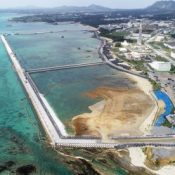
February 1, 2019 Ryukyu Shimpo
On January 31, it came to light that the Japanese government is considering using approximately 60,000 sand pillars at a depth 70 meters under the water of Oura Bay as the soil improvement method on a 57-hectare area of soft seafloor in the land reclamation area for the Futenma relocation site in Henoko, Nago City.
At the end of last year the Okinawa Defense Bureau (ODB) announced to agencies including the Ministry of Land, Infrastructure, Transport and Tourism (MLIT) and the Okinawa Prefectural Government (OPG) that it estimated a total of 40,000 pillars for ground reinforcement.
Out of the 40,000, 20,000 would be used under a portion of seawalls, and the other 20,000 would be used in a land reclamation section.
However, additional boring surveys in the area found that further reinforcement will be necessary.
Since the beginning of this year the estimated number of sand pillars needed has increased to 60,000 in total.
Toward using this kind of soil improvement method on the soft seafloor, on January 31 Prime Minister Shinzo Abe answered inquiries at a plenary session of the House of Representatives.
This is the first time someone representing the administration has mentioned the intention to apply for authorization from the OPG on a revised construction plan.
In regard to this matter, Governor Denny Tamaki said, “Once we listed the soft seafloor as a reason to revoke [the land reclamation permit], the government took notice. The central government should immediately halt construction and hold negotiations with the prefectural government.” 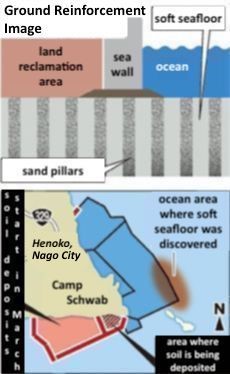
With these words Governor Tamaki called for a halt to construction, indicating that he does not intend to authorize the revised construction plan.
In the report drawn up by the commissioned vendors for the soil improvement work being considered by the Japanese government, there is mention of the method that may be used in Oura Bay.
The report itemizes 60,000 sand pillars as part of a technique called the “sand compaction pile method,” in which sand pillars are powerfully compacted into the ground using a casing pipe, which will increase the density of the seafloor.
About 40,000 sand pillars are to be used in this method for the seawall portion.
In the land reclamation area, about 20,000 sand pillars are to be driven into the ground and water pressed out from the soil in a procedure called the “sand drain method.”
About 17 hectares of the seawall area and about 40 hectares of the land reclamation area are up for soil improvement.
Reinforcement on each area is expected to take place at a depth of 70 meters underwater.
In regard to the use of an estimated 40,000 sand pillars for the plan in Decemeber last year, a central government employee said, “There will be full-blown examinations after this, so the actual number of pillars is still unclear.
In working out the construction period and costs, I hope to keep [the number of pillars] few.”
On January 30, Prime Minister Shinzo Abe for the first time stated his administration’s view that the existence of soft seafloor on the Oura Bay side of the land reclamation area means that ground reinforcement is necessary.
At that time he did not touch on the topic of an application for the revised plan.
On January 31 at the House of Representatives plenary session, in response to Chairman of the Japanese Communist Party Kazuo Shii, Prime Minister Abe explained, “Due to the addition of ground reinforcement work, and because it is essential to apply to the Okinawa Prefectural Government for authorization of the revised plan, the Okinawa Defense Bureau must first conduct necessary examinations.”
(English translation by T&CT and Erin Jones)
Go to Japanese
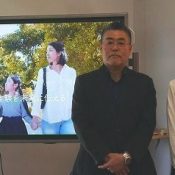
February 2, 2019 Ryukyu Shimpo
As part of its 30th anniversary project, the Himeyuri Peace Museum released a promotional video on its website and on YouTube.
The museum’s annual visitation had declined by nearly one-half, from its peak of one million visitors in 1999, to 580,000 in 2017.
The promotional video aspires to publicize the museum and increase visitors.
The Himeyuri Peace Museum hosted a private viewing on Feb. 1, and the museum director gave the opening remarks.
“Currently, 74 years has passed since World War II, and there are people who are not even aware of Himeyuri,” Chokei Futenma, 59, said.
“We’re at a juncture in which the generation born after the war will pass on the atrocious memories of the Battle of Okinawa to a generation that hasn’t experienced war.
We will explore ways to do that, while keeping pace with the times.”
Film director Takako Miyahira, 39, said of her work, “Rather than the atmosphere of the exhibit, I captured the peaceful side of the museum.
For the video, I envisioned a parent’s wish for their children to be happy.”
The video is a three-minute story of a family from the main islands visiting the Himeyuri Peace Museum.
Through Yoshiko Shimabukuro’s account of the war, the family emphasizes with sentiments of the surviving former students (which served as the catalyst for building the museum), and learns the importance of longing for peace.
Click herefor the official Himeyuri Peace Museum website.
(English translation by T&CT and Monica Shingaki)
Go to Japanese

February 1, 2019 Ryukyu Shimpo
By Masaaki Umeda and Ami Chibana
A specific type of scam called “international romance fraud” has been on the rise in and outside of Okinawa. This scam involves perpetrators pretending to be foreign servicemen on social networking services (SNS) and dating apps to defraud women of money by making women fall in love with them.
They pretend to be in the dangerous and harsh field of war and flatter women with promises of love to swindle them out of money using various excuses.
Victims have been transferring money into specified bank accounts before meeting with the perpetrators who claim they are military personnel.
Misaki Smith is a representative of a non-profit organization (NPO) Women’s Pride that provides consultation on problems that arise in relationships between Americans and Japanese.
She warns that, “Servicemen are well-trusted, so the scammers are likely to pretend to be military personnel.
They will emphasize that they are wealthy and the one thing that they have in common is that they will frequently say ‘I want to see you’ and ‘I want to marry you.
’ I don’t want people to ever send money to people they have never met.”
Last year, Women’s Pride provided counsel to women ages 20 to 50 in and outside of Okinawa that experienced this scam.
Last August, a single woman in her 50s living in the Kansai region sought counsel.
After registering for a dating service on a major portal website, she received a Facebook message.
The sender claimed to be a U.S. army surgeon serving on the frontline in the Middle East and often courted the woman and wanted to marry her.
The sender requested that she hold on to something that was important to him. However, in order to receive the goods, she was to transfer money into a specified bank account.
The woman had received a photo of the man’s ID and even spoke with him over a videophone.
She then tried to transfer the 800,000-yen as instructed, but the financial institution would not allow the funds to be transferred to the specified account in the Middle East.
The man then provided her with an address in Chiba Prefecture and asked that she transfer the money to a post office account instead.
Finding this suspicious, the woman sought counsel from Women’s Pride and found out that it was a scam.
The woman said, “Even though I had not met him, I got lost in and moved by the words like ‘I don’t want to die here (in the field of war)’ and “I’ll escape and come to you.’ I had my suspicions, but I just thought foreigners casually use these sorts of passionate phrases.”
Smith who handled the woman’s case was surprised when she saw the photo ID that was sent by the perpetrator.
The pay grade did not match the rank and the uniform worn in the photo did not match the rank.
In another photo in which the man is wearing a white coat was of a doctor that actually exists, but someone else’s face photoshopped in.
Smith points out that she “is pretty sure there are much more people who are crying themselves to sleep after suffering the damages of the scam.”
Regarding the name “romance fraud,” she said, “It’s inappropriate since it can give off a positive impression. To prevent further damage, the name should be changed.”
(English translation by T&CT and Chelsea Ashimine)
Go to Japanese
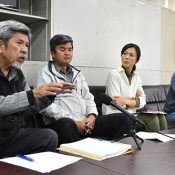
February 2, 2019 Ryukyu Shimpo
A group of U.S. and Japanese environmentalists, which is the plaintiff group in the dugong lawsuit against the U.S. Department of Defense (DoD) and demands a halt to construction in Henoko, Nago City, held a press conference on February 1 at the Prefectural Office in which it has reported the submission of its brief to the U.S. federal court of appeals.
Following the judicial decision made in August last year, the plaintiffs are again claiming that the DoD failing to hold discussions with local interested parties is in violation of the National Historic Preservation Act (NHPA).
It is expected that the DoD will submit its brief to the court after about a month.
There are more than 100 pages to the plaintiffs’ brief submitted on January 2.
The plaintiffs also claim that the report from the DoD stating, “new base construction will have no negative effect on the dugong” violates the procedure established by the NHPA, and is an arbitrary argument.
Member of the Nago City Assembly and one of the plaintiffs, Takuma Higashionna, said, “Actually, the dugong have left.
This outcome should never have come about, if only the Department of Defense had listened to local interested parties.
” Yoshikazu Makishi of the Okinawa Environment Network expressed his support of the plaintiffs, saying, “In the appeal proceedings, I am cheering on Okinawa where I can.”
Initially, the DoD planned to submit its brief documents by February 1, but it has been delayed due to the U.S. government shutdown.
After documents have been submitted, the court will decide on matters such as the exchange of additional documents and about holding a public trial.
(English translation by T&CT and Erin Jones)
Go to Japanese

January 30, 2019 Ryukyu Shimpo
On January 29, 16 Nago residents living in the vicinity of the landfill area resorted to legal action at the Naha district court to seek cancellation of the state’s decision to suspend revocation of the landfill permit.
Japan’s Minister of Land, Infrastructure, Transport, and Tourism (MLIT) suspended the revocation based on the Administrative Appeal Act.
The plaintiffs’ aim is to prove the illegality of this method by the MLIT, by which it has made the prefectural government’s permit revocation ineffectual.
Nago City Council Member Takuma Higashionna said at a press conference at the Okinawa Bar Association, “We have already suffered from the construction and the temporarily restricted areas.
We want a real trial soon.”
According to their complaint, the plaintiffs are planning to claim that the Minister of Land, Infrastructure, Transport, and Tourism who made the decision is not a neutral third party to this situation and cannot act as an examining agency.
The plaintiffs believe that as a national institution the Okinawa Defense Bureau is not subject to the Administrative Appeal Act, which is meant to protect the rights and interests of Japanese citizens, and therefore the Act cannot be used in this way.
One lawyer representing the plaintiffs, Peku Chun, said, “Both the Minister of Land, Infrastructure, Transport, and Tourism and the defense bureau are national engines.
They seem to be in collusion to infringe on the rights of people.
We would like to stop the construction as soon as possible.”
(English translation by T&CT and Megumi Chibana)
Go to Japanese

January 30, 2018 Ryukyu Shimpo
Nago – Andres Higa ,43, a second generation Okinawan-Argentinian who has established the “World Uchinanchu Day” and “ International Day of Nikkei,” married Cynthia Higa ,36, a third generation Okinawan-Peruvian, on New Year’s Eve.
The two submitted their marriage registration at Nago City Hall.
Andres said, “It was coming to Okinawa that brought us together.
From now, we want to combine our strengths and work for the Uchinanchu people.”
Andres came to Okinawa in 2007, when he attended Meio University for graduate school.
Afterwards, he worked to establish such things as the “World Uchinanchu Student Summit,” as well as the World Uchinanchu day and International Day of Nikkei.
Andres is also involved in various volunteer activities for Uchinanchu who have migrated to Okinawa from abroad.
Andres and Cynthia met in Okinawa in 2007.
Cynthia says smiling, “I want to create a family where the smiles never end, and support Andres in helping Uchinanchu.”
(English translation by T&CT and Sam Grieb)
Go to Japanese
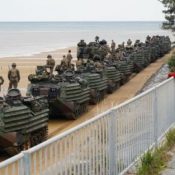
January 29, 2019 Ryukyu Shimpo
On January 28, fifteen U.S. military amphibious vehicles entered U.S. military Camp Hansen by crossing over prefectural highway 329 from the Katabaru seashore in Matsuda, Ginoza, Okinawa. When the vehicles crossed, U.S. military personnel temporarily stopped traffic by ordinary vehicles traveling along the highway. Local residents commented what a nuisance it was.
The amphibious vehicles departed one after another from two U.S. military landing ships located off the coast of Katabaru and stood wait in the shallows. When all fifteen reached the shore, a member of the U.S. military temporarily stopped traffic with a sign reading “Vehicles Crossing,” and the amphibious vehicles crossed the road.
“It is pathetic that the U.S. military can use Okinawa’s land however it likes. Okinawa is not at peace in the least,” fumed a 63 year old female resident of Ginoza Village who was at the scene. Village councilman Tomomasa Tsukayama, age 64, said, “This is a normal part of the U.S. military’s training, and each time they cross they stop traffic. It’s quite a nuisance.”
(English translation by T&CT and Sandi Aritza)
Go to Japanese












 Webcam(Kokusai Street)
Webcam(Kokusai Street)


